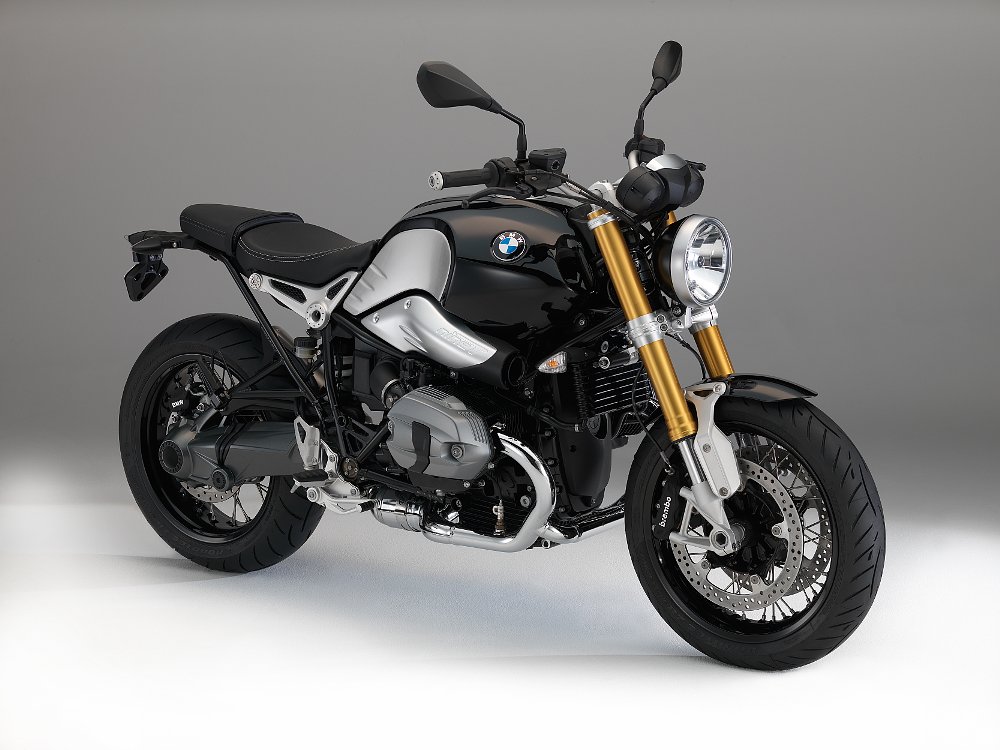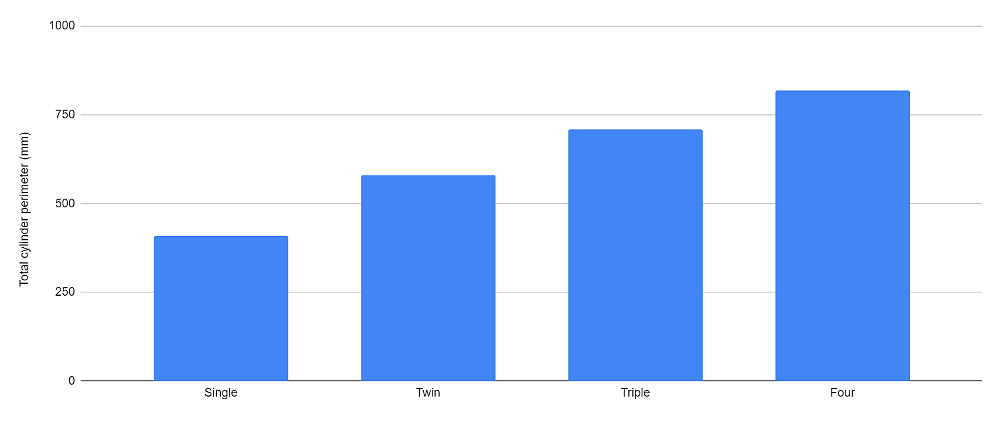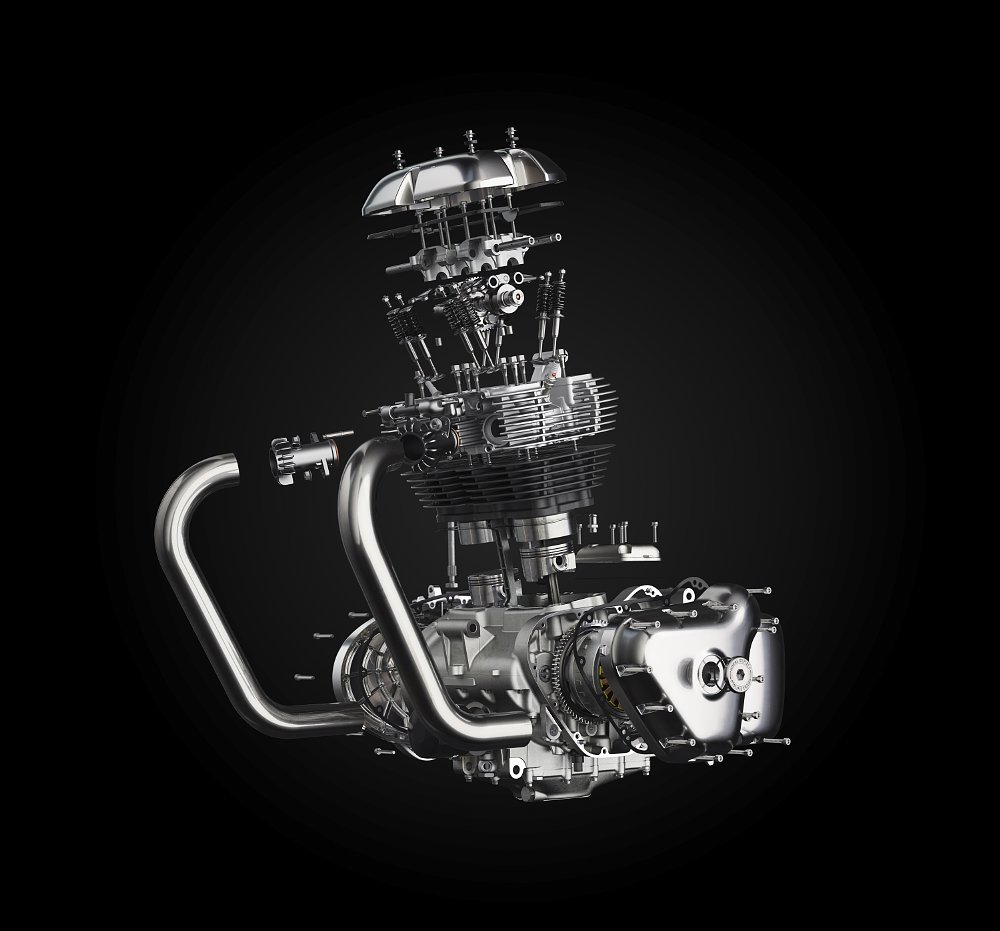You wrote only "r x F" on your birthday wish list and now your friends are worriedly checking up on you. Maybe they don't understand, but I hear your cry. It's torque you want.
Displacement, cubes, the old "how big's the motor?" — this is not a surefire indicator of a motorcycle's peak torque, but it's a heavy influence. Power and torque are related by a simple equation, but the latter is the direct product of expanding fuel-air charge in a cylinder. If the bore gets bigger that's more force applied to the piston, and if the stroke gets longer it has better leverage on the crank. Either way you slice it, a bigger displacement is going to have a positive impact on torque.
In cruisers, baggers, and their ilk, torque is all-important number, measuring just how effortlessly you'll waft down the boulevards or across the windswept plains. But what about the rest of us? Can we measure displacement and dollars and use math to come up with an ideal? To keep the task manageable, let's limit our inquiry to the current crop of non-cruiser twins.

Why do we have so many twins?
After decades of de facto angry bees, we are firmly (back) in the age of twins. But why?
If you listen very closely, you can almost hear the crinkle of paper in the irate hands of the engineers and product planners. Euro 5+ emissions standards handed down from the halls of power in any language you'd like as long as you'll comply. There's no fighting physics. Given a fixed displacement and stroke, adding cylinders increases total cylinder perimeter as seen in the graph below. The space around the piston above the first ring provides a pocket for unburnt fuel charge to reside and is referred to as crevice volume. When this unburnt charge escapes out the exhaust, it's bad for emissions. Two cylinders will help you get costs down, crevice volume down, and torque up.

Luckily for me, I love twins. My first motorcycle was an enigmatic twist factory, a Buell XB9SX which saw me through those tumultuous early riding days. If you like a lot of midrange and feeling the engine rumble away beneath you, it's likely you love twins, as well. So, twin lover, which of today's esteemed manufacturers will give you the most engine for cheap?
To find the answer, I compiled a list of every twin currently sold and compared its purchase price to its engine size. I found it a surprisingly messy business deciding what models get invited, so I laid out some rough rules, as follows.
- Naked, sport, ADV versions of a platform all get a spot as long as the price differs.
- 2023 and 2024 models are both included.
- Nothing feet-forward or with cruising, bagging, or roadgliding as its primary mission.
- Must have more than two inches of rear suspension travel. (This rule feels oddly specific.)
- An overwhelming variety of V-Stroms can be simplified as needed.
Now that I've established airtight and supremely logical rules, let's see who the winners are. I certainly didn't expect number one, which is pretty deep into the article to put the clickbait. The Top 10 are as follows:
| Model | Base MSRP | Displacement | Dollars/CC | Cooling |
|---|---|---|---|---|
| BMW R nineT Pure | $10,995 | 1170 | $9.40 | Air |
| Royal Enfield INT650 | $6,149 | 648 | $9.49 | Air |
| Royal Enfield Continental GT | $6,349 | 648 | $9.80 | Air |
| CFMOTO 700CL-X | $6,899 | 693 | $9.96 | Liquid |
| BMW F 900 R | $8,995 | 895 | $10.05 | Liquid |
| Triumph Bonneville T120 | $12,695 | 1200 | $10.58 | Liquid |
| CFMOTO 800NK | $8,499 | 799 | $10.64 | Liquid |
| Triumph Speed Twin 1200 | $12,895 | 1200 | $10.75 | Liquid |
| Triumph Speed Twin 900 | $9,895 | 900 | $10.99 | Liquid |
| BMW R nineT Scrambler / Urban GS | $12,995 | 1170 | $11.11 | Air |
Each cubic centimeter in the R 9T Pure costs less than two Big Macs. Outstanding. Before crunching the numbers, I was sure that the INT650 I had recently ridden was the surefire value-jug champion, being an almost shockingly cheap 650. I marveled at how the mediocre spec sheet transformed into such a delightful riding experience; surfing the torque swell while listening to the 270-degree "blat" elevated the street-riding experience well above my old Ninja 400's trundling abilities. This is the promise of the big iron. But it's torque we're after (remember "r X F"?), so let's dive deeper into the number crunching.
| Model | Base MSRP | Displacement | Foot-pounds of torque | @rpm | Dollars/foot-pound | CC/foot-pound |
|---|---|---|---|---|---|---|
| BMW R 9T Pure | $10,995 | 1170 | 85 | 6,000 | $129.35 | 13.76 |
| BMW F 900 R | $8,995 | 895 | 67 | 6,500 | $134.25 | 13.36 |
| CFMoto 700 CLX | $6,899 | 693 | 50.2 | 6,500 | $137.43 | 13.80 |
| CFMoto 800NK | $8,499 | 799 | 59.7 | 8,000 | $142.36 | 13.38 |
| BMW R 9T Scr/Urban GS | $12,995 | 1170 | 85 | 6,000 | $152.88 | 13.76 |
| Triumph Speed Twin 1200 | $12,895 | 1200 | 83 | 4,250 | $155.36 | 14.46 |
| Royal Enfield INT650 | $6,149 | 648 | 38.35 | 5,250 | $160.34 | 16.90 |
| Triumph Bonneville T120 | $12,695 | 1200 | 77.4 | 3,500 | $164.02 | 15.50 |
| Royal Enfield Continental GT | $6,349 | 648 | 38.35 | 5,250 | $165.55 | 16.90 |
| Triumph Speed Twin 900 | $9,895 | 900 | 59 | 3,800 | $167.71 | 15.25 |
Shuffled another way, these top results can tell us a different story. When we sort by torque per dollar, the BMW and CFMOTO offerings now hog all the top spots. Why? The answer is in the rightmost column, which is a rough approximation of BMEP, or Brake Mean Effective Pressure. This is the mathematical expression of how much cylinder pressure an engine can generate and a high value means that not only is the cylinder getting filled effectively, but also that the fuel-air charge is well mixed and burned quickly.

As the above table shows us, the Royal Enfield engines cannot work their charge very effectively, possibly due to a lack of optimization on account of development or production costs, packaging constraints, or simply the low 9.5:1 compression ratio, which directly affects cylinder pressure and therefore torque. The Triumph engines seem to be optimized for relatively low rpm torque peaks where it’s possible that the air charge can’t gain enough momentum to inertia-charge the cylinder, and the small cams optimized for midrange might not let in as much air as otherwise could be realized by the relatively large cylinder displacement. These theories are borne out by the Speed Twin 1200 and 900 seeing more torque at higher rpm.
OK, Poindexter, fun science lesson, but let's add a crumb of context, shall we? What about those floundering failures at the bottom of the list? Surely we won't see any beloved small ADV bikes begging for a seemingly obvious engine upgrade, right? Let’s take a look.
| Model | Base MSRP | Displacement | Dollars/CC | Dollars/foot-pound | CC/foot-pound | @RPM |
|---|---|---|---|---|---|---|
| Ducati SuperSport | $15,495 | 937 | $16.54 | $224.57 | 13.58 | 6,500 |
| Yamaha YZF-R3 | $5,499 | 321 | $17.13 | $252.25 | 14.72 | 9,000 |
| Aprilia RS660 | $11,499 | 659 | $17.45 | $232.77 | 13.34 | 8,500 |
| Ducati DesertX | $17,095 | 937 | $18.24 | $251.40 | 13.78 | 6,500 |
| Aprilia Tuareg 660 | $12,299 | 659 | $18.66 | $238.35 | 12.77 | 6,500 |
| Ducati Streetfighter | $17,995 | 955 | $18.84 | $240.57 | 12.77 | 9,000 |
| Ducati Panigale V2 | $18,595 | 955 | $19.47 | $242.44 | 12.45 | 9,000 |
| Ducati Multistrada V2 S | $19,295 | 937 | $20.59 | $271.76 | 13.20 | 7,750 |
| Kawasaki Versys-X 300 | $6,199 | 296 | $20.94 | $322.86 | 15.42 | 10,000 |
| Ural Gear Up | $21,999 | 749 | $29.37 | $523.79 | 17.83 | 4,300 |
Here we have it, the wall of shame(lessness). These offerings might be making good on other deliverables, but they cackle as you stuff endless loose bills into the engine dispenser before spitting out your twin. (Except you, Ural Gear Up. I'm sorry for dragging you into this. Keep doing your best.)
Here at the bottom of the list you might be paying over twice the amount per cc as the top finishers, with the markup on torque numbers tagging right along. But if you ignore the dollars for a minute, what you might notice is that the cc/foot-pound, or the BMEP stand-in discussed earlier, is in many cases better at the bottom of this list than the top finishers. This checks out when you consider that many of these are more expensive models and come from manufacturers with the resources to wring the maximum possible torque from a given size of engine.
The numbers point out characteristics. The Ducati 955 Superquadro engine needs to get up to 9,000 rpm to reach peak torque, likely a product of its giant bore and short stroke making cylinder filling a tough ask at low rpm. Once there it makes effective use of that charge, however. Meanwhile, the Kawasaki Versys-X 300 must be made of painted platinum for it to make us pay over $300 dollars to unlock each foot-pound of what amounts to a cat fart's worth of peak torque. Somewhere between this exorbitant price per CC and the absolute value of BMW's modernized tractor engine lies the midpack finisher, the Kawasaki Z400. New riders will be glad to know it has a new, until-now unexplored facet of pure adequacy.
Before we leave this land of charts and graphs, let's use some rudimentary spreadsheet tools to look for the true spirit of the big iron. Not just individual motorcycles, but which companies are truly bringing torque to the people? Can we declare a People's Champion of Cubes? Here's the formula: PCC Index = Number of Models * Correction Factor/Base MSRP * Average Cost Per CC.
This equation rewards a manufacturer that offers more twins, with lower prices, and lots of displacement for those prices. I believe that a real champion of the people doesn’t paywall physics' gifts and wants to give them to you in as many flavors as possible. So how did the companies fare?
| Brand | No. models | Avg Dollars/cc | Avg price | PCC Index |
|---|---|---|---|---|
| Kawasaki | 8 | $14.61 | $7,930 | 6.90 |
| BMW | 12 | $12.78 | $14,262 | 6.59 |
| CFMOTO | 5 | $11.48 | $7,239 | 6.02 |
| Honda | 7 | $14.18 | $8,885 | 5.56 |
| Yamaha | 6 | $14.42 | $7,932 | 5.24 |
It's Kawasaki from under the ring with a steel chair! When looked at from a whole-value perspective, it's hard to ignore the Japanese manufacturers that have been quietly, perhaps too quietly, delivering good motorcycles at good prices. Triumph just missed the top five but also doesn't have the breadth of twin-powered machines that most of the top finishers can tout. Despite Euro brands having a reputation for quality and performance over value, BMW still believes in a big twin and while it costs more, it also delivers more.
If you want to keep slicing the data, I invite you to access to my spreadsheet.
I hope you leave with a clearer picture of where to go for your torque fix, and while I'm not recommending that you go out and buy an R nineT Pure based just on the numbers, I certainly understand why you would.








